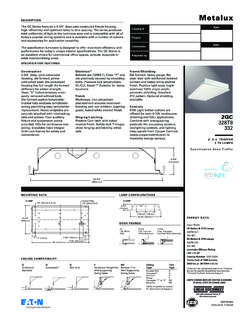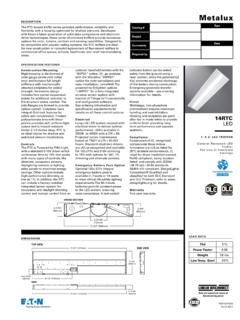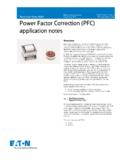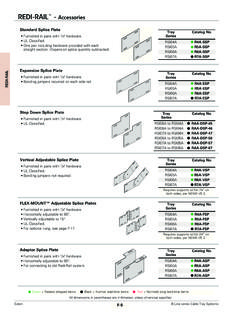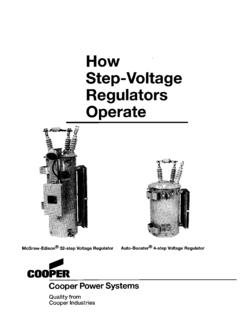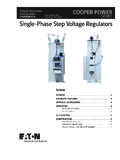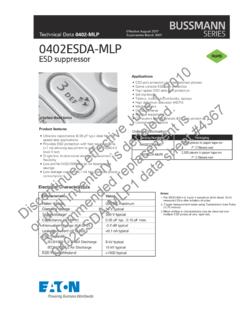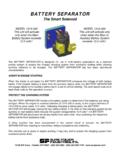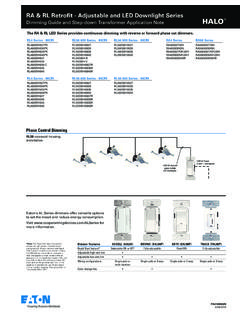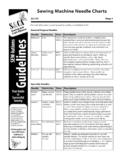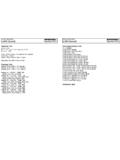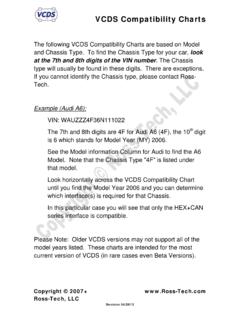Transcription of Component Protection - Cooper Industries
1 Component Protection How To Use Current-Limitation Charts Analysis of Current-Limiting Fuse Let-Through Charts Prior to using the Fuse Let-Through Charts, it must be determined what let- The degree of current-limitation of a given size and type of fuse depends, in through data is pertinent to equipment withstand ratings. general, upon the available short-circuit current that can be delivered by the Equipment withstand ratings can be described as: How Much Fault Current electrical system. Current-limitation of fuses is best described in the form of a can the equipment handle, and for How Long? Based on standards presently let-through chart that, when applied from a practical point of view, is useful to available, the most important data that can be obtained from the Fuse Let- determine the let-through currents when a fuse opens.
2 Through Charts and their physical effects are the following: Fuse let-through charts are plotted from actual test data. The test circuit that A. Peak let-through current: mechanical forces establishes line A-B corresponds to a short circuit power factor of 15%, that is B. Apparent prospective RMS symmetrical let-through current: heating effect associated with an X/R ratio of The fuse curves represent the cutoff value of the prospective available short-circuit current under the given circuit C. Clearing time: less than 1 2 cycle when fuse is in it's current-limiting range (beyond where fuse curve intersects A-B line). conditions. Each type or class of fuse has its own family of let-through curves. This is a typical example showing the short-circuit current available to an 800A.
3 The let-through data has been generated by actual short- circuit tests of circuit, an 800A Low-Peak current-limiting time-delay fuse, and the let-through current-limiting fuses. It is important to understand how the curves are data of interest. generated, and what circuit parameters affect the let-through curve data. Typically, there are three circuit parameters that can affect fuse let-through 800 Amp Low-Peak Current-Limiting Time-Delay performance for a given available short-circuit current. These are: Fuse and Associated Let-Through Data 1. Short-circuit power factor 2. Short-circuit closing angle 3. Applied voltage Current-limiting fuse let-through curves are generated under worst case conditions, based on these three variable parameters.
4 The benefit to the user is a conservative resultant let-through current (both Ip and IRMS). Under actual field conditions, changing any one or a combination of these will result in lower let-through currents. This provides for an additional degree of reliability when applying fuses for equipment Protection . Current-Limiting Let-Through Charts for Cooper Bussmann fuses are near the back of this book. Analysis of a Current-Limiting Fuse B. INSTANTANEOUS PEAK LET-THROUGH CURRENT IN AMPS. 400,000 Available Peak Short- 300,000 Circuit Current = 198,000A. I. 200,000 Available RMS Short- Circuit Current = 86,000A. 100,000. 80,000 Peak Let-Through Current 60,000 800A of Fuse= 49,000A. RMS Let-Through Current 30,000 of Fuse = 21,000A.
5 20,000. TIME. tm ta 10,000 tc tm = Fuse Melt Time 8000 ta = Fuse Arc Time 6000 tc = Fuse Clearing Time 4000. RATING. 3000. AMP. A. 2000. 1000. 10,000. 20,000. 30,000. 40,000. 60,000. 100,000. 200,000. 80,000. 1000. 2000. 3000. 4000. 6000. 8000. PROSPECTIVE SHORT-CIRCUIT CURRENT SYMMETRICAL RMS AMPS. 68 2005 Cooper Bussmann Component Protection How To Use Current-Limitation Charts How to Use the Let-Through Charts Most electrical equipment has a withstand rating that is defined in terms of an Using the example given, one can determine the pertinent let-through data for RMS symmetrical-short-circuit current, and in some cases, peak let-through the KRP-C-800SP amp Low-Peak fuse. The Let-Through chart pertaining to current.
6 These values have been established through short circuit testing of the 800A Low-Peak fuse is illustrated. that equipment according to an accepted industry standard. Or, as is the case with conductors, the withstand rating is based on a mathematical calculation A. Determine the PEAK let-through CURRENT. and is also expressed in an RMS short-circuit current. Step 1. Enter the chart on the Prospective Short-Circuit current scale at 86,000 amps and proceed vertically until the 800A fuse If both the let-through currents (IRMS and Ip) of the current-limiting fuse curve is intersected. and the time it takes to clear the fault are less than the withstand rating Step 2. Follow horizontally until the Instantaneous Peak Let-Through of the electrical Component , then that Component will be protected from Current scale is intersected.
7 Short circuit damage. Step 3. Read the PEAK let-through CURRENT as 49,000A. (If a fuse The following Table shows typical assumed short-circuit current ratings for had not been used, the peak current would have been various unmarked components. 198,000A.). B. Determine the APPARENT PROSPECTIVE RMS Typical Short-Circuit Current Ratings For Unmarked SYMMETRICAL let-through CURRENT. Components*. Step 1. Enter the chart on the Prospective Short-Circuit current scale Short- Circuit Component at 86,000A and proceed vertically until the 800A fuse curve is Rating, kA. intersected. Industrial Control Equipment: Step 2. Follow horizontally until line A-B is intersected. a. Auxiliary Devices 5. b. Switches (other than Mercury Tube Type) 5.
8 Step 3. Proceed vertically down to the Prospective Short-Circuit c. Mercury Tube Switches Current. Rated over 60 amperes or over 250 volts 5. Step 4. Read the APPARENT PROSPECTIVE RMS SYMMETRICAL Rated 250 volts or less, 60 amperes or less, and over 2kVA let-through CURRENT as 21,000A. (The RMS Rated 250 volts or less and 2kVA or less 1. SYMMETRICAL let-through CURRENT would be 86,000A if Meter Socket Base 10. there were no fuse in the circuit.) Photoelectric Switches 5. Receptacle (GFCI Type) 10. Current-Limitation Curves Cooper Bussmann Receptacle (other than GFCI Type) 2. Low-Peak Time-Delay Fuse KRP-C-800SP Snap Switch 5. Terminal Block 10. Thermostat 5. *Based upon information in UL 891 (Dead-Front Switchboards).
9 The following components will be analyzed by establishing the short-circuit withstand data of each Component and then selecting the proper current- limiting fuses for Protection : Wire and Cable Bus (Busway, Switchboards, Motor Control Centers and Panelboards). Transfer Switches HVAC Equipment Ballasts Circuit Breakers A detailed analysis of motor circuit Component Protection is provided later in the section on motor circuits. C. Clearing time If the RMS Symmetrical available is greater than the point where the fuse characteristic curve intersects with the diagonal A-B line, then the fuse clearing time is 1 2 cycle or less. In this example, the intersection is approximately 9500A; so for short-circuit currents above approximately 9500A, this KRP-C-800SP fuse is current-limiting.
10 The current-limiting charts and tables for Cooper Bussmann fuses are in the rear of this book under Current-Limiting Let-Through Charts. Refer to these tables when analyzing Component Protection in the following sections. 2005 Cooper Bussmann 69. Cooper Bussmann Current-Limiting Fuse Let-Through Data See pages 67 to 69 for current-limiting definition and how to analyze these charts. Low-Peak Class L Time-Delay Fuses KRP-C_SP Fuse RMS Let-Through Currents (kA). KRP-C_SP Fuse Size Prosp. 1000000. Short 601 800 1200 1600 2000 2500 3000 4000 5000 6000. 900000. 800000 B. 700000 IRMS IRMS IRMS IRMS IRMS IRMS IRMS IRMS IRMS IRMS. 600000. 500000 5,000 5 5 5 5 5 5 5 5 5 5. 400000. 6000A 10,000 8 10 10 10 10 10 10 10 10 10.
